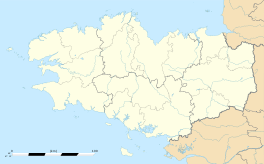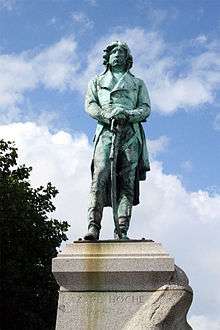Quiberon
| Quiberon Kiberen | ||
|---|---|---|
|
The beach at Quiberon | ||
| ||
 Quiberon | ||
|
Location within Brittany region  Quiberon | ||
| Coordinates: 47°29′03″N 3°07′09″W / 47.4842°N 3.1192°WCoordinates: 47°29′03″N 3°07′09″W / 47.4842°N 3.1192°W | ||
| Country | France | |
| Region | Brittany | |
| Department | Morbihan | |
| Arrondissement | Lorient | |
| Canton | Quiberon | |
| Government | ||
| • Mayor (2008—2014) | Jean-Michel Belz | |
| Area1 | 8.83 km2 (3.41 sq mi) | |
| Population (2008)2 | 5,049 | |
| • Density | 570/km2 (1,500/sq mi) | |
| Time zone | CET (UTC+1) | |
| • Summer (DST) | CEST (UTC+2) | |
| INSEE/Postal code | 56186 / 56170 | |
| Elevation |
0–33 m (0–108 ft) (avg. 15 m or 49 ft) | |
|
1 French Land Register data, which excludes lakes, ponds, glaciers > 1 km² (0.386 sq mi or 247 acres) and river estuaries. 2 Population without double counting: residents of multiple communes (e.g., students and military personnel) only counted once. | ||
Quiberon (Breton: Kiberen) is a commune in the Morbihan department in Brittany in western France.
It is situated on the southern part of the Quiberon peninsula, the northern part being the commune of Saint-Pierre-Quiberon. It is primarily known as a seaside resort for French tourists during summer, and for its history of sardine production.
History

During the Seven Years' War the bay was the site of the Battle of Quiberon Bay between the French and British fleets. In the French Revolution, in July 1795 Quiberon was used by French Royalist exiles, with assistance from the British, as the base for a failed invasion of Brittany (traditionally a royalist area). The invasion was defeated by the Revolutionaries under General Lazare Hoche.
In the 19th century, Nicolas Appert, a chemist, developed a technique that permitted the sterilization of food. Thanks to this process, Quiberon became the leading harbour for sardine fishing and the production of canned sardines in France. Many families from the Finistère département migrated to Quiberon for the fishing season (May to October). When the men put out to sea, the women worked in the sardine can factories.
The railway between Auray and Quiberon was inaugurated in 1882. It deeply changed Quiberon's way of life. Fishing, canning and the exploitation of seaweed has been replaced by tourism. At that time, some famous people went to Quiberon for a stay, including the writers Gustave Flaubert and Anatole France, and the actress Sarah Bernhardt. The year 1924 was important for the peninsula because it was classified as health resort. Now, the main resources for Quiberon come from tourism.
During the Second World War, Penthièvre Fort at the narrow isthmus (see photo) was occupied by the Germans and incorporated into the Atlantic Wall. It housed various blockhouses, but was mainly used by the infantry. In July 1944, 59 resistance fighters were tortured and buried alive there. A Cross of Lorraine mounted on a stone pillar, with a plaque listing the names of the fighters stands there in memory of them. Although the fort is still of military importance (as a training base), a gallery (tunnel) where the bodies were discovered can be visited.
Monuments

- Église Notre-Dame de Locmaria, 19th century chapel
- Prehistoric site
- Museum of History and traditions : La maison du Patrimoine
- Musée de la mer (Museum of the sea)
- Monument to the Battle of Quiberon between the Revolutionaries and Royalists
Transport
- Quiberon railway station has a summer train service to Auray, which offers connections to Paris and other places in France.
From September to July a bus service operates between Quiberon and Auray.
Quiberon Aerodrome is open all year and accessible by private aircraft. The hard runway is 775m long and the tower staff speak both English and French on the radio.[1]
Demographics
Inhabitants of Quiberon are called Quiberonnais.
Twinning
Quiberon is twinned with:[2]
 Looe, Cornwall, UK
Looe, Cornwall, UK-
 Kempten, Bavaria, Germany, since 1971 (initially with the municipality St. Mang)
Kempten, Bavaria, Germany, since 1971 (initially with the municipality St. Mang) -
 Le Grand Bornand, Haute-Savoie, France, since 1997
Le Grand Bornand, Haute-Savoie, France, since 1997 -
 Josselin, Morbihan, France
Josselin, Morbihan, France
Use in popular culture
Quiberon is the home of a professional Quidditch team operating within the fictional Harry Potter universe. The Quiberon Quafflepunchers team members players wear shocking-pink robes.[3]
See also
References
- ↑ "Quiberon ville aerodrome". Ville Quiberon. Retrieved 14 July 2014.
- ↑ (French) Quiberon official website Archived May 5, 2016, at the Wayback Machine.
- ↑ Whisp, Kennilworthy (2001). Quidditch Through the Ages. WhizzHard Books. pp. 31–46. ISBN 1-55192-454-4.
External links
| Wikimedia Commons has media related to Quiberon. |
| Wikivoyage has a travel guide for Quiberon. |
- City website (French)
- Tourism Office website (French), (English)
- TV Quiberon 24/7 WORLD (English)
- French Ministry of Culture list for Quiberon (French)
- Map of Quiberon on Michelin (English)
- Quiberon webzine (French)
.jpg)
